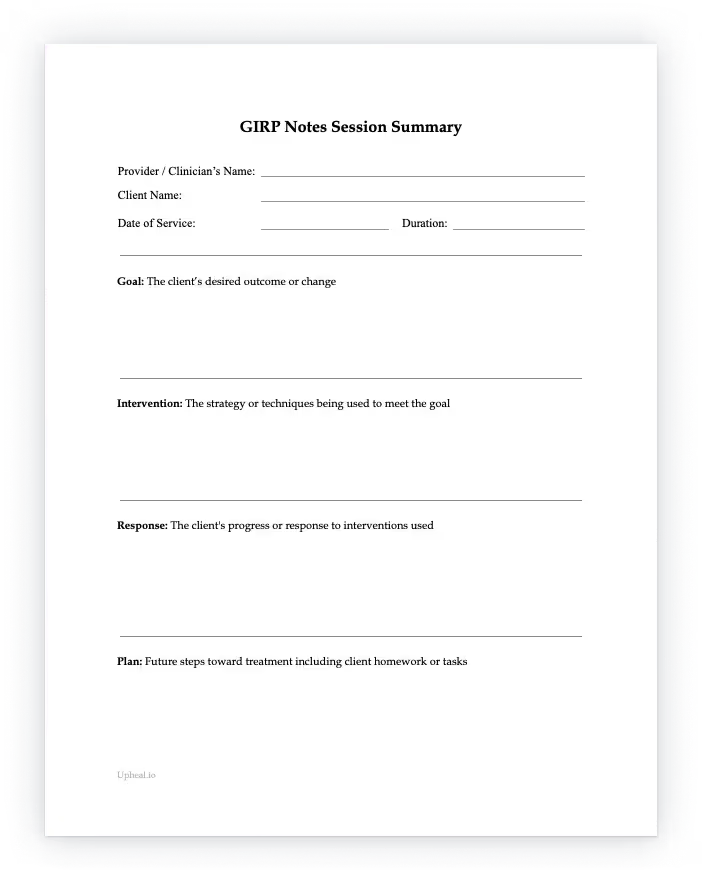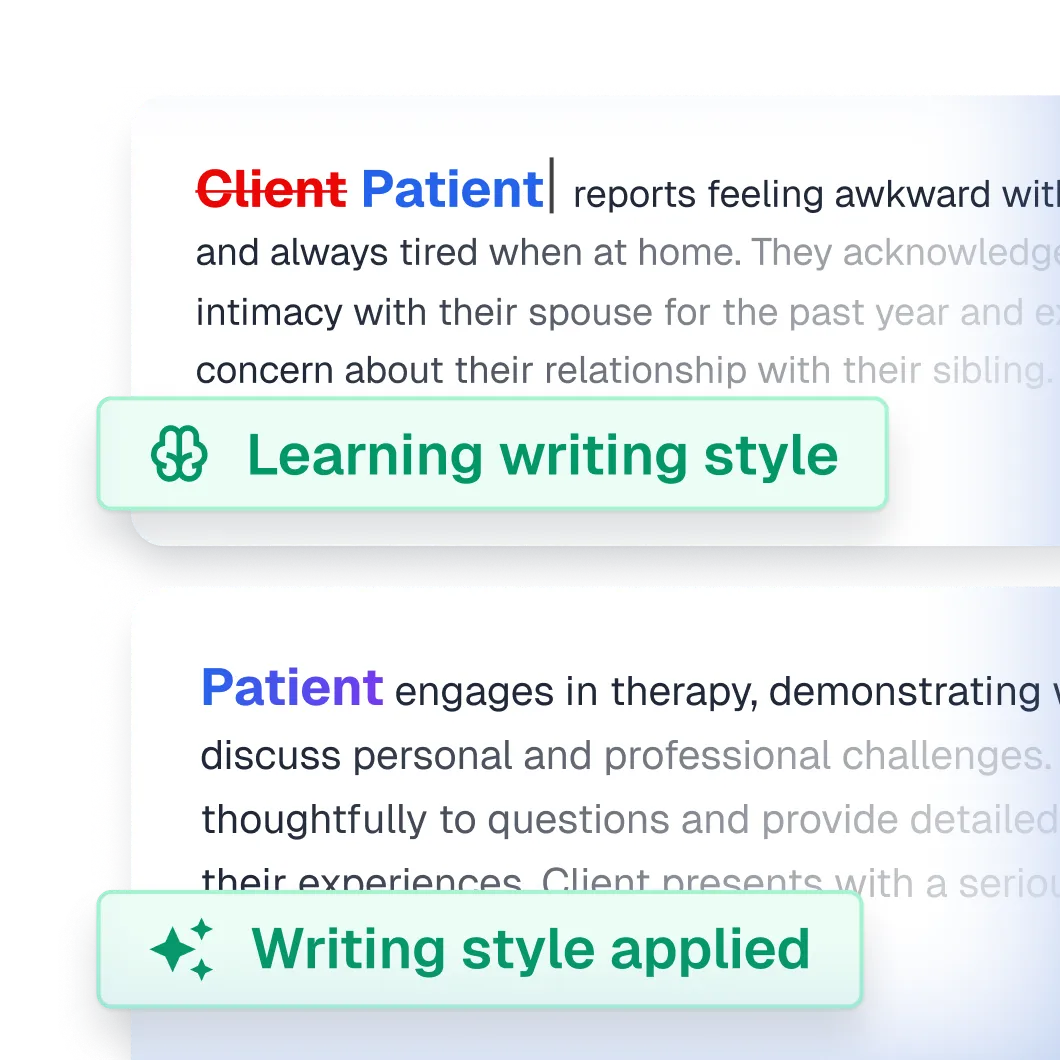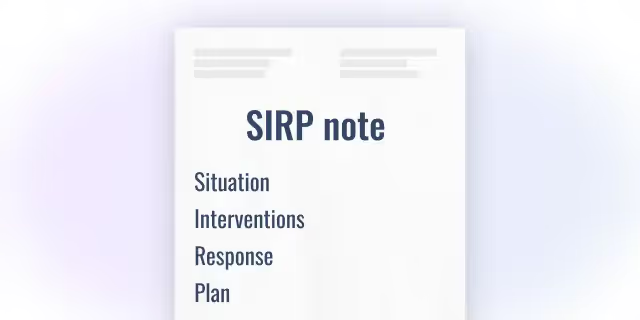How to write GIRP notes for therapy (with example)
Ever feel like your therapy note-taking could be more organized, efficient, and easy?
A lot of mental and behavioral health professionals feel the same way. Especially when providing goal-oriented therapy.
That’s why it’s important to have a standard and effective way to take therapy notes. One that’s time-tested and therapist-approved.
That’s where GIRP notes come in.
GIRP notes allow you to keep track of your clients’ progress toward their goals. By tracking a client’s therapy goals using GIRP notes, you’ll make therapy more effective.
What is a GIRP note?
A GIRP note is a structured method of documenting therapy sessions.
GIRP stands for Goals, Interventions, Response, and Plan.
This format helps you systematically record important details about each session. Using GIRP notes, you can ensure that all critical aspects of the client's progress and your approach are captured.
By focusing on these four components, GIRP notes provide a clear and organized way to track the therapeutic journey.
GIRP note components
- Goals (G)
What are the objectives for the therapy session? This could include both short-term and long-term goals. - Interventions (I)
What techniques or strategies were used during the session? This might include specific therapeutic approaches or exercises, like CBT or mindfulness. - Response (R)
How did the client respond to the interventions? This section captures the client's feedback, reactions, and progress. This is critical for tracking what works and what doesn’t. - Plan (P)
What are the next steps? This outlines the future course of action, including any homework, upcoming session goals, or changes to the treatment plan.
GIRP notes example
To illustrate how GIRP notes can be applied in practice, let’s consider a hypothetical therapy session with a client dealing with anxiety.
- Goal: The client wants to reduce their anxiety levels by learning and using coping mechanisms.
- Intervention: Introduced deep breathing exercises and discussed cognitive-behavioral techniques to manage anxiety.
- Response: The client was receptive to the breathing exercises and reported feeling slightly less anxious. They expressed interest in learning more about cognitive-behavioral techniques.
- Plan: Assign deep breathing exercises as daily homework and plan to introduce more cognitive-behavioral techniques in the next session.
In reality, your GIRP Notes will (and should) be much longer than the above example. That’s even more true if you rely on insurance, which can open your practice up to audits.
Let's explore a detailed example to demonstrate the versatility of GIRP notes in different therapeutic contexts. In the GIRP note below, a client is struggling with career-related stress and decision-making.
This detailed example illustrates how GIRP notes can be tailored to various therapeutic situations. You can see how a GIRP note provides a comprehensive and structured approach to session documentation.
Why use the GIRP template?
Using the GIRP template offers numerous benefits for therapists and their clients.
Firstly, it provides structure and clarity to session notes, ensuring that all critical aspects of the therapy session are documented in an organized manner.
This structured approach helps therapists stay focused on the key elements of each session, making it easier to review and reference notes later.
Additionally, GIRP notes enhance communication between therapists and clients by clearly outlining goals, interventions, responses, and plans. This transparency can foster a stronger therapeutic alliance and better client engagement.
Moreover, the GIRP format facilitates goal tracking and progress measurement, allowing both therapists and clients to see tangible improvements over time.
GIRP note template pdf
Use our free GIRP note template for your client sessions – it’s free to download.

Use a GIRP note in these situations
GIRP notes are particularly useful in the following scenarios:
- Group therapy: In group therapy settings, GIRP notes can help document individual goals and interventions within the group context, ensuring each member's progress is tracked.
- Brief interventions: For short-term therapy sessions, the structured format of GIRP notes helps capture the essential elements quickly and efficiently, providing a clear overview of the session.
- Life transitions: During significant life changes, such as career shifts, relationship changes, or major relocations, GIRP notes can help track the client's adaptation process and the effectiveness of interventions.
- Change-resistant clients: For clients who are resistant to change, GIRP notes can highlight the small but significant progress made in each session, helping to motivate and encourage continued effort.
- Crisis intervention: In situations where clients are experiencing acute stress or crisis, GIRP notes can provide a clear and concise record of immediate goals, interventions used to stabilize the client, their response to these interventions, and the plan for follow-up care. This ensures that critical information is not lost and can be effectively communicated to other healthcare providers if needed.
GIRP note vs SOAP note
GIRP notes differ from SOAP notes (Subjective, Objective, Assessment, Plan) in their focus and structure.
While SOAP notes are designed to capture clinical observations and assessments, GIRP notes emphasize goal-setting and client responses.
SOAP notes follow a medical model, documenting the patient's subjective experience, the therapist's objective observations, the assessment of the situation, and the plan for treatment.
In contrast, GIRP notes start with identifying specific goals for the session, followed by the interventions used, the client's response to these interventions, and the plan for future sessions.
This makes GIRP notes particularly useful for goal-oriented therapies where client progress and engagement are crucial.
GIRP notes vs BIRP notes
Comparatively, BIRP notes (Behavior, Intervention, Response, Plan) focus more on the client's behaviors and how they change in response to interventions.
Both GIRP and BIRP notes include interventions, responses, and plans, but GIRP notes begin with a clear statement of the session's goals.
BIRP notes are typically used in contexts where observing and modifying specific behaviors is the primary focus, such as in behavioral therapy.
On the other hand, GIRP notes are ideal for settings where setting and achieving goals is paramount.
Choosing between GIRP and BIRP notes depends on the therapeutic context and the specific needs of the client.
GIRP notes vs. DAP notes
GIRP notes and DAP notes (Data, Assessment, Plan) serve different purposes in therapy.
DAP notes capture objective data, assess the client’s condition, and outline future plans.
They are ideal for clinical settings where detailed observations and professional assessments are necessary.
GIRP notes, on the other hand, start with setting specific goals, documenting interventions, recording client responses, and planning future sessions.
This format is perfect for goal-oriented therapies focusing on client progress and engagement.
Choosing between GIRP and DAP notes depends on your therapy context and needs.
For goal-focused sessions, GIRP notes are best. For clinical documentation, DAP notes are more suitable.
How to write a GIRP note
Follow these four steps to write an effective GIRP note:
In all, each section of your GIRP note should be around five sentences. That allows for enough insight and helps protect you during an insurance audit.
If you’d like help creating your GIRP notes, try Upheal’s free plan with 15 AI-written notes per month.
Additional Insights
At Upheal, we recommend the GIRP note for therapists who:
- Prioritize goal-oriented therapy: GIRP notes help keep sessions focused and aligned with specific therapeutic goals, making it easier to track progress and adjust strategies as needed.
- Need a clear framework for session documentation: The structured format of GIRP notes ensures comprehensive and organized documentation, which is crucial for maintaining high standards in therapeutic practice.
- Want to enhance client engagement and accountability: By clearly outlining goals and recording client responses, GIRP notes encourage active participation from clients and help them stay accountable for their progress.
GIRP notes are also highly useful for coaching. They ensure that both the coach and the client are on the same page regarding goals and progress.
Why choose Upheal for your GIRP notes?
At Upheal, we specialize in safe, HIPAA-secure AI note-taking for therapy.
Our service gives therapists back an average of 6 hours per week. So when our HIPAA-compliant AI note-taking does your GIRP notes for you, you’re free to serve your clients better.
Here are some important features you’ll love about our AI note-taking software:
- Every type of therapy note: Our platform creates BIRP notes, SOAP notes, DAP notes, Progress notes, and more. For therapists interested in leveraging technology, therapy notes can be created seamlessly with Upheal’s AI note-taking software. This can significantly reduce the time spent on documentation, allowing more time for direct client interaction.
- Enhanced Accuracy and Efficiency: AI-assisted GIRP notes can enhance accuracy and efficiency in note-taking, ensuring that all critical details are captured without manual effort. Of course, you can always review and edit what we’ve created for you.
- Data Security and Confidentiality: At Upheal, we prioritize the security and confidentiality of client data. Our AI note-taking solutions are designed to meet the highest standards of data protection, ensuring your practice remains compliant with all relevant regulations.
By using AI solutions, you can streamline your documentation process, improve the quality of your notes, and ultimately provide better care for your clients.
Whether you’re in a private practice, a group setting, or offering coaching services, GIRP notes offer a versatile and effective way to enhance your professional practice.
Conclusion
GIRP notes are an invaluable tool for therapists and coaches, offering a structured approach to documenting client sessions.
By using GIRP notes, you can improve the quality of your practice and support your clients more effectively.
They help in maintaining a clear record of goals, interventions, responses, and future plans, ensuring that both therapists and clients are aligned in their therapeutic journey.
FAQs about GIRP notes
What is the difference between GIRP and BIRP notes?
GIRP notes focus on Goals, Interventions, Response, and Plan, emphasizing goal-setting and client feedback. BIRP notes, on the other hand, concentrate on Behavior, Intervention, Response, and Plan, highlighting behavioral aspects. Each serves different purposes depending on the therapeutic context.
Why do counselors take notes?
Counselors take notes to document the progress and details of therapy sessions. This ensures continuity of care, helps track client progress, and provides a legal record of the therapeutic work. Notes also assist in planning future sessions and interventions based on the documented history.
How to write a GIRP note?
To write a GIRP note, follow these steps:
- Goals: Identify the specific objectives for the session.
- Interventions: Record the techniques and strategies used during the session.
- Response: Note the client's reactions and feedback to the interventions.
- Plan: Outline the next steps and future actions for subsequent sessions.
How detailed should therapy notes be?
Therapy notes should be detailed enough to provide a clear record of the session, including goals, interventions, client responses, and plans. They should include essential information while being concise and to the point, avoiding unnecessary details that do not contribute to the therapeutic process.
How do you write therapy notes quickly?
To write therapy notes quickly:
- Use a structured template like GIRP to streamline the process.
- Write notes immediately after the session while details are fresh.
- Focus on key points: goals, interventions, client responses, and future plans.
- Use bullet points or shorthand for faster documentation.
- Leverage AI note-taking tools like Upheal to automate and speed up the process.














